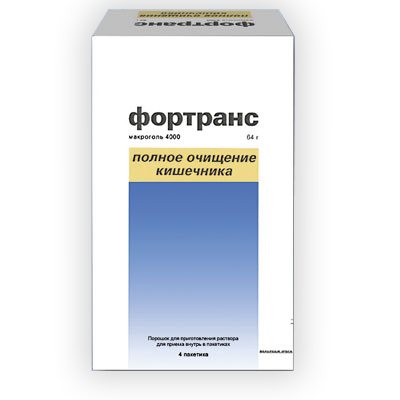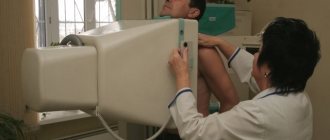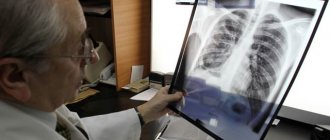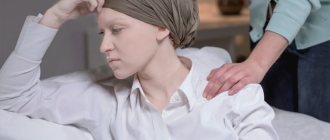Several diagnostic methods are used to identify intestinal diseases. Laboratory methods and computed tomography are considered the most complex. Endoscopic diagnostic methods are simpler and more accessible; they require much less time. These methods of examining the intestines are very similar to each other, but still have some differences.
Fibercolonoscopy
Fibercolonoscopy (FCS) is an endoscopic method of examining the inner walls of the colon using a special device - a colonoscope. A colonoscope consists of a thin flexible tube into which a fiber optic light guide is mounted. At the end of the probe there is an LED and a camera, which transmits the image to a computer screen through an optical fiber.
Another name for this method is video colonoscopy. Many patients are interested in what is the difference between fibrocolonoscopy and colonoscopy. In fact, these are different names for the same method.
The probe is inserted into the anus, and the doctor gently manipulates the tube, examining the condition of the colon lining in real time. The method allows you to examine the colon along its entire length.
In addition, the colonoscope has a device for performing biopsies. It is also possible to remove polyps and other benign tumors.
Colonoscopy
Colonoscopy
Colonoscopy (fibrocolonoscopy, colonofibroscopy) is a method of endoscopic diagnosis of diseases of the colon.
Colonoscopy is an important method for diagnosing colon diseases. It is performed using a special device - a colonoscope, of which there are currently quite a few different models.
In many countries, this study is performed by a coloproctologist; in Russia, it is performed by an endoscopist, which makes the use of colonoscopy even more informative. Colonoscopy, which has devices for photographing, performing biopsies and removing various pathological neoplasms, is a method for clarifying the diagnosis of diseases of the entire colon - from the cecum to the rectum. Every coloproctological patient should undergo a colonoscopy for rectal polyps and, even more so, for cancer of the distal colon detected during sigmoidoscopy. In these cases, it is necessary to examine the entire colon so as not to miss synchronous tumor or inflammatory changes located above the level reached by a rigid rectoscope or fibrosigmoidoscope. It should be borne in mind that irrigation and colonoscopy do not compete, but complement each other. Colonoscopy is indispensable for follow-up of patients after removal of polyps, after conservative treatment of ulcerative colitis, and especially for regular examinations of the colon in patients operated on for colon cancer.
Today, colonoscopy is the most informative method for early diagnosis of benign and malignant tumors of the colon, nonspecific ulcerative colitis, Crohn's disease, etc. and allows in 80-90% of cases to examine the entire colon. During a colonoscopy, the condition of the colon mucosa is visually assessed. During colonoscopy, it is also possible to perform various therapeutic procedures - removal of benign tumors, stopping bleeding, removal of foreign bodies, recanalization of intestinal stenosis, etc.
| Colon polyp | Colon diverticula | Colon cancer |
Indications for colonoscopy
The indication for a colonoscopy is suspicion of any disease of the colon.
Indications for colonoscopy are the widest. First of all, it should be performed if a tumor is suspected; in these cases, its resolution is significantly higher than irrigoscopy. Tumors and polyps of minimal size are detected. Colonoscopy is indicated for inflammatory diseases of the colon, especially ulcerative colitis and Crohn's disease. It is also used in emergency situations with intestinal bleeding, obstruction, and the presence of foreign bodies.
Sometimes an x-ray of the colon is performed before a colonoscopy.
Contraindications
The study is contraindicated in acute infectious diseases, peritonitis, as well as in the late stages of heart and pulmonary failure, severe disorders of the blood coagulation system. Colonoscopy should not be performed in patients with severe forms of ulcerative and ischemic colitis.
Technique
Colonoscopy is usually performed without anesthesia. For patients with severe pain in the anus, local anesthesia (dicaine ointment, xylocaingel) is indicated. In case of severe destructive processes in the small intestine or massive adhesions in the abdominal cavity, it is advisable to perform a colonoscopy under general anesthesia, which is mandatory for children under 10 years of age. The duration of the study strongly depends on the anatomical features of the patient’s gastrointestinal tract and his psycho-emotional status and under normal conditions does not exceed 30 minutes.
A colonoscopy is a fairly complex procedure, so try to help your doctor and nurse as much as possible by following their instructions. You will experience some discomfort during the test, but your doctor will do everything possible to reduce any discomfort. In many ways, following the instructions exactly makes it easier to endure the procedure.
You will have to remove all clothing from the waist down, including underwear. You will then be helped to lie on a couch or examination table on your left side, with your knees drawn up to your chest.
The colonoscope is inserted through the anus into the lumen of the rectum and gradually moves forward with a moderate supply of air to straighten the lumen of the intestine. During the examination, as directed by your doctor, you will be helped to turn onto your back or back onto your left side.
In some pathological conditions, to clarify the diagnosis, a microscopic examination of the changed areas of the mucous membrane is necessary, which the doctor takes with special forceps - a biopsy is performed, which extends the examination time by 1-2 minutes.
During a colonoscopy, you will have a feeling that your intestines are full of gases, causing you to have the urge to defecate. At the end of the study, the air introduced into the intestine is sucked out through the endoscope channel. Pain during this procedure is moderate because the intestine stretches when air is introduced into it. In addition, at the moment of overcoming the bends of the intestinal loops, intestinal displacement occurs. At this point, you will experience a short-term increase in pain.
How to behave after the study?
Immediately after the procedure, you can drink and eat. If the feeling of fullness of the abdomen with gases persists and the intestines are not emptied of remaining air naturally, you can take 8-10 tablets of finely crushed activated carbon, stirring it in 1/2 cup of warm boiled water. It is better to lie on your stomach for several hours after the examination.
Complications
Complications of colonoscopy, the most dangerous of which is bowel perforation, are very rare.
The success and informativeness of the study is determined mainly by the quality of preparation for the procedure, so pay the most serious attention to following the recommendations below. In order to examine the mucous membrane of the colon, it is necessary that there is no feces in its lumen.
Option #1
If you do not suffer from constipation, that is, the absence of independent stool for 3 days, then preparation for the study is as follows:
1. 2 days before the colonoscopy, you must switch to a special (slag-free) diet, excluding vegetables and fruits, potatoes, herbs, berries, mushrooms, legumes, and brown bread from your diet. Allowed: broth, semolina porridge, egg, boiled meat, boiled sausage, fish, cheese, butter, fermented milk products, except cottage cheese.
!!! On the eve of the colonoscopy and on the day of the examination, only liquid food is allowed - boiled water, broth, tea.
2. On the eve of the colonoscopy at 14-15 hours you need to take 30-40 grams of castor oil (2 tablespoons). For more comfortable use, the oil can be dissolved in half a glass of kefir.
Replacement of castor oil - aqueous solution of magnesium sulfate 30% - 150 ml at a time. Other laxatives (pursenide; bisacodyl 5 tablets - taken on the eve of a colonoscopy at 12.00 noon - stool usually appears after 6-8 hours) do not completely cleanse the colon, so they should be used in the preparation process if castor oil is intolerant. After independent bowel movements, you need to do 2 enemas of 1.5 liters of regular, room temperature water. Enemas are given at 20 and 21 hours.
3. On the morning of the colonoscopy (usually at 8 and 9 am), you need to do 1-2 more similar enemas, but always with “clean” water.
!!! There is no need to fast the night before and on the day of the test. You can drink broth, tea, mineral water, juice.
!!! During the days of preparation for a colonoscopy, you can take the medications you need, with the exception of iron supplements and activated carbon.
If you have a tendency to constipation, then to prepare for a colonoscopy you need to additionally follow several recommendations: 3-4 days before the study you need to switch to the special diet described above; At the same time, you need to take the laxatives you usually use every day. Further preparation does not differ from the above.
Option No. 2
Preparation for colonoscopy with the drug "Fortrans" (France)

The drug "Fortrans" is intended for preparing the gastrointestinal tract for diagnostic studies (including colonoscopy and irrigoscopy) as well as for surgical interventions on the intestines.
The required degree of cleansing of the large intestine is achieved:
- no cleansing enemas
- without additional laxative intake
- without long-term adherence to a slag-free diet
- without outside help
- no abdominal pain or excessive gas formation
The drug solution has a fruity taste. This type of preparation is ideal for patients with diseases of the liver, gallbladder and pancreas.
The action of the drug is based on the combination of a high molecular weight polymer with an isotonic solution of electrolytes, which prevent the absorption of water from the stomach and intestines. The solution promotes accelerated bowel emptying. The presence in the solution of electrolytes corresponding to the osmotic pressure of physiological solution replenishes the intestinal secretion of potassium, sodium, chlorine bicarbonate, and therefore there are no changes in the composition of body fluids.
There are two possible types of preparation with Fortrans:
A. One-stage preparation with Fortrans.
The day before (the day before the test), exclude vegetables, fruits, potatoes, berries, mushrooms, and greens from your diet.
On the day of colonoscopy, you can only drink sweet tea and boiled water.
On the day of colonoscopy, depending on your weight (up to 50 kg - 2 sachets, 50–80 kg - 3 sachets, over 80 kg - 4 sachets), the drug is diluted in water boiled at room temperature at the rate of 1 sachet per 1 liter of water, the required amount of solution Drink on the day of colonoscopy from 5-6 to 10 am in fractional portions (a glass every 15-20 minutes). The solution can be washed down with boiled water. The stool begins to pass 1.0-1.5 hours after starting to take the drug and stops 2-3 hours after taking the last dose of the drug.
On the day of the test, before the colonoscopy, you can drink a cup of sweet tea.
Colonoscopy may be performed no earlier than 4 hours after the last dose of the drug.
B. Two-stage preparation with the drug “Fortrans”.
Preparation is carried out both on the eve of the colonoscopy and on the day of the study.
On the eve of the colonoscopy, breakfast is allowed until 12 noon (semolina, yogurt, scrambled eggs, tea). After 12.00 clear broth, tea, and boiled water are allowed.
On the eve of the colonoscopy, depending on your weight (up to 50 kg - 1 sachet, 50-80 kg - 2 sachets, over 80 kg - 3 sachets), the drug is dissolved in water boiled at room temperature at the rate of 1 sachet per 1 liter of water. The required amount of solution is drunk from 17 to 20-21 hours in fractional portions (a glass every 15-20 minutes). The solution can be washed down with boiled water. The stool begins to pass 1.0-1.5 hours after starting to take the drug and stops 1-3 hours after taking the last dose of the drug.
On the day of colonoscopy, from 7 to 9 a.m., drink another 1 liter of solution at the rate of 1 sachet per 1 liter of water. After taking the last dose of the drug, stool stops after 1-2 hours. The solution can be washed down with boiled water. Colonoscopy may be performed no earlier than 4 hours after the last dose of the drug.
!!! During the days of preparation for a colonoscopy, you can take the medications you need, with the exception of iron supplements and activated carbon.
Emergency colonoscopy in patients with intestinal obstruction and bleeding can be performed without preparation. It is effective when using special endoscopes with a wide biopsy channel and active irrigation of the optics.
Option #3
Preparation for colonoscopy with Lavacol (Russia)
Description:
Powder of white or white with a yellowish or grayish tint. One packet of the drug is dissolved in 200 ml of water. The resulting solution is a colorless or slightly colored liquid, slight opalescence is allowed.
Indications for use:
Preparation for endoscopic or x-ray examination of the colon, as well as for surgical interventions that require the absence of contents in the intestine.
Contraindications:
Severe disturbances in the patient's general condition (including dehydration, heart failure), intestinal obstruction, toxic expansion of the colon, gastric stenosis, perforation of the stomach or intestines, erosive and ulcerative lesions of the gastrointestinal tract, impaired renal function.
Directions for use and dosage:
The contents of the package (14 g) are dissolved in 200 ml of water. Take 3 liters of solution (approximately 200 ml with an interval of 20 minutes) orally on an empty stomach 18-20 hours before examination or surgery. During and after the intake, only liquid food is consumed. Recommended hours for taking the drug are 14.00 - 19.00. After 10 pm, eating is not recommended.
Side effect:
In rare cases, nausea and vomiting, a feeling of heaviness and discomfort are possible when taking the first doses of the drug.
Conditions for dispensing from pharmacies:
Without a doctor's prescription.
Release form:
Powder in bags of 14 g of combined film material. 15 bags, along with instructions for use, are placed in a cardboard pack.
Best before date:
3 years. Do not use after the expiration date stated on the package.
- -Diagnostic methods in proctology
- -Diagnostic method anoscopy
- -Sigmoidoscopy (rectoscopy)
- -Digital examination of the rectum
- -Sphincterometry
- -Probe research
- -Test with dye
- -Biopsy
- -X-ray of the colon
- -Ultrasonography
Indications for FCS and sigmoidoscopy
There are a number of general indications for both diagnostic methods:
- chronic diarrhea and constipation;
- constant pain of unknown nature;
- blood and mucus in the stool;
- polyps;
- Crohn's disease;
- peptic ulcer;
- suspicion of cancer;
- inflammatory processes;
- anemia,
- weight loss.
FCS is also performed for intestinal obstruction and ulcerative colitis, and sigmoidoscopy for chronic hemorrhoids to identify hemorrhoids.
Alternative diagnostic methods
Colonoscopy is considered the most informative method of examining the entire colon for the presence of neoplasms or various painful lesions in the intestine. However, a number of contraindications to this diagnostic procedure, as well as the possible categorical reluctance of the patient to perform such a diagnosis, lead to the need to search for alternative methods for examining the colon and the condition of its mucous membrane.
One of these alternative methods for diagnosing the intestines is sigmoidoscopy. However, it is worth considering that with sigmoidoscopy it is possible to examine the entire rectum and only 30 cm of the colon.
Contraindications to intestinal endoscopy
Fibercolonoscopy and sigmoidoscopy cannot be performed in the presence of the following diseases:
- myocardial infarction;
- stroke;
- stage 3 hypertension;
- peritonitis;
- respiratory failure
- acute forms of inflammation;
- acute inflammation of anal fissure;
- acute infectious diseases;
- hemorrhoidal thrombophlebitis.
Our clinic is equipped with modern endoscopic equipment, which makes it possible to accurately and quickly diagnose gastrointestinal diseases, as well as perform surgical operations to remove benign tumors.






